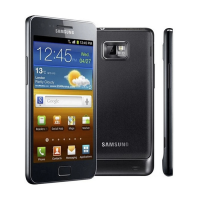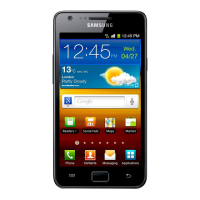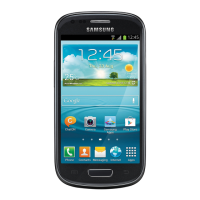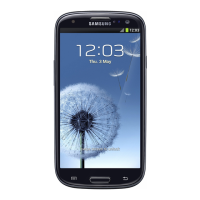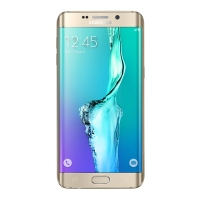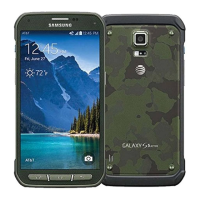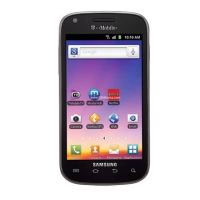Do you have a question about the Samsung Galaxy S II Skyrocket and is the answer not in the manual?
Explains how to configure hardware, activate service, and set up Voicemail.
Information on powering the device with a rechargeable Li-ion battery and using the Travel Charger.
Instructions on connecting the charger to the phone and AC outlet for charging.
Overview of key phone features including processor, OS, display, camera, and connectivity.
Guide to personalizing the home screen by creating shortcuts and managing widgets.
Information about using microSD cards for memory expansion and SD card functionality.
Instructions on dialing a number using the on-screen keypad and initiating a call.
Instructions on how to answer or reject an incoming call and send a voicemail.
Functions available during an active call, such as Hold, Add call, Keypad, and End call.
On-screen buttons for Hold, Add call, Keypad, and End call during an active call.
Menu for configuring call settings like rejection, messages, ringtones, and keypad tones.
Overview of available text input methods: Samsung keyboard, Google Voice typing, and Swype.
Guide to using the on-screen QWERTY keypad in portrait and landscape orientations.
Using predictive text for next-letter prediction and error correction.
How to use voice input for text entry by speaking into the microphone.
Guide to entering text by sliding a finger from letter to letter.
Details on adding contact information like name, phone number, and assigning pictures.
Displays options for contacts: history, edit, delete, join, mark as default, share, assign speed dial.
Controls for playing music: pause, rewind, fast-forward, volume, repeat, and shuffle.
Playing music files added to the device or copied from a PC.
Controls for playing videos: pause, rewind, fast-forward, volume, PIP, and screen views.
Simple steps for taking pictures: choosing subject, pointing, and pressing the camera key.
Settings for Exposure value, Focus mode, Timer, Resolution, and White balance.
Options for GPS tag, shutter sound, image quality, storage, and reset.
Steps to record video, pause, stop, save, and review video files.
Detailed options for Effects, Settings, Self-recording, Recording mode, and Exposure value.
Overview of message types: Text, Multimedia, Email, Google Talk, Google +, and Messenger.
Steps to compose and send text or multimedia messages to recipients.
Options before composing a message: search, delete threads, draft, scheduled, locked, spam, and settings.
Additional options during message composition: call, smiley, add text, contacts, view contact, slides, recipients, scheduled.
Options for adding audio, recording audio, memos, calendar events, and location as attachments.
Display settings (bubble, background style) and general settings (delete old messages).
Reviewing and creating email, and receiving message alerts.
Setting up and automatically synchronizing Gmail accounts.
Steps to compose and send Gmail messages, including recipients and subject.
Options for viewing Gmail messages: archive, delete, labels, mark unread, newer/older.
Using Google Talk for instant messaging, with saved conversation logs in Gmail.
Describing Wi-Fi settings and how to connect to networks.
Steps to turn on Wi-Fi and scan for available networks.
Activating Bluetooth, assigning device name, and scanning for devices to pair.
Viewing mobile data usage and turning mobile data capability on or off.
Sharing phone's mobile data connection via USB or as a Wi-Fi hotspot.
Setting up and configuring a mobile Wi-Fi hotspot, including SSID and password.
Controlling phone sounds including volume, vibration intensity, ringtones, and device vibration.
Changing display settings like font, orientation, brightness, screen timeout, and wallpaper.
Viewing memory allocation and mounting/unmounting the SD card.
Options for unmounting, formatting, and managing the SD card.
Viewing battery usage by activities and applications.
Choosing settings for unlocking the screen: swipe, motion, pattern, PIN, password, or none.
Options for screen lock: Swipe, Motion, Pattern, PIN, Password, and None.
Determining the security level for your phone.
Requiring PIN or password to decrypt phone or encrypt SD card data.
Configuring display language and onscreen keyboard options.
Changing the keyboard used by the device and configuring input methods.
Setting Samsung keyboard options and configuring Google voice typing.
Configuring Samsung keyboard options like keypad types, languages, predictive text, and continuous input.
Setting Predictive Text options like word completion, spell correction, and next word prediction.
Configuring Swype settings including vibration, sound, auto-spacing, and capitalization.
Setting speech options for Voice input, including language and blocking offensive words.
Backing up device settings and data to Google server and resetting phone to factory defaults.
Resetting phone and sound settings to factory defaults.
Setting up, managing, and synchronizing accounts, including Google and email accounts.
Activating accessibility services for users with physical disabilities.
Accessing phone information like model, firmware, software update, and status.
Connecting to network to upload and automatically update phone software.
Adjusting browser settings like home page, form auto-fill, and text encoding.
Clearing cache, history, cookies, form data, and managing passwords and notifications.
Information about Wi-Fi technology and connecting to Wireless Access Points (WAPs).
Steps to turn on the Wi-Fi feature to discover and connect to networks.
Connecting to detected Wi-Fi networks by entering passwords if necessary.
Enabling Wi-Fi Direct for device-to-device connections and data transfer.
About Bluetooth technology and connecting wireless devices.
Changing Bluetooth name and making the device visible for pairing.
Establishing trusted connections between devices by sharing a passkey.
Connecting device to PC via USB for synchronization, data transfer, or wireless access.
Connecting device as a removable disk to access file directory and memory card.
Setting auto-reply for calls/messages when driving and allowing contacts to reach you.
Accessing real-time GPS-driven applications for navigation and local searches.
Maximizing battery, data, simplifying Wi-Fi access, and tracking data usage.
Accessing the mobile web and its basic features.
Consulting calendar, creating events, and setting alarms.
Using the 8.0 megapixel camera to produce photos and shoot videos.
Accessing alarms, world clock, stopwatch, and timer.
Managing alarm volume, tone, location, snooze, smart alarm, and naming alarms.
Managing daily contacts by storing names and numbers in the Address Book.
Reviewing and creating email, and receiving message alerts.
Viewing photos and videos, basic editing, slideshows, and sharing.
Setting up and automatically synchronizing Gmail accounts.
Messaging and sharing with friends through Circles, Messenger, and Instant Upload.
Viewing maps, business info, directions, and posting messages.
Navigating with maps, using search, directions, layers, and additional options.
Sending and receiving different types of messages.
Sharing phone's mobile data connection via USB or Wi-Fi hotspot.
Playing music files and creating playlists.
Managing sounds, images, videos, and other data in one location.
Managing AT&T account: review bill, check usage, upgrade device, change rate plan.
Getting real-time driving directions using GPS.
Renting and downloading movies and television shows.
Playing music files added to device or copied from PC.
Installing applications and games, and providing feedback.
Creating and saving Word, Excel documents, and viewing PowerPoint and PDF files.
Using Google Talk for instant messaging with saved conversation logs.
Recording settings: limit for MMS, contextual filename, default name, and end option.
Searching the web using voice commands.
Information on RF energy exposure from wireless phones and FDA safety precautions.
Steps to minimize RF exposure, including using speaker mode or headsets.
Suggestions for maintaining the mobile device, keeping it away from liquids and heat.
Common sense recommendations for safe listening with portable audio devices.
Maintaining separation between mobile device and implantable medical devices to avoid interference.
Safety precautions for individuals with implantable medical devices using mobile devices.
Using Global Positioning System (GPS) signals for location-based applications.
Using maps and directions, confirming instructions, and obeying road signs.
Operating the device for essential communications and making emergency calls.
Details coverage and duration of the limited warranty for Samsung devices and accessories.
Specifies warranty periods for phone, batteries, case, and other accessories.
Lists exclusions from the Limited Warranty, including misuse and unauthorized accessories.
Samsung's responsibility to repair or replace products under warranty.
Procedures for returning the product for service, including proof of purchase and contact information.
Disclaimers on third-party software and limitations of liability.
Resolving disputes exclusively through final and binding arbitration.
| Network Technology | GSM / HSPA / LTE |
|---|---|
| Announced | 2011, October |
| Dimensions | 129.8 x 68.8 x 9.5 mm (5.11 x 2.71 x 0.37 in) |
| SIM | Mini-SIM |
| Display Type | Super AMOLED Plus |
| Resolution | 480 x 800 pixels, 5:3 ratio (~207 ppi density) |
| Protection | Corning Gorilla Glass |
| Chipset | Qualcomm APQ8060 Snapdragon S3 |
| CPU | Dual-core 1.5 GHz Scorpion |
| GPU | Adreno 220 |
| Card Slot | microSD, up to 32 GB |
| Internal Storage | 16 GB |
| RAM | 1 GB |
| Main Camera | 8 MP, AF |
| Video | 1080p@30fps |
| Selfie Camera | 2 MP |
| Loudspeaker | Yes |
| 3.5mm jack | Yes |
| WLAN | Wi-Fi 802.11 a/b/g/n, dual-band, Wi-Fi Direct, hotspot |
| Bluetooth | 3.0, A2DP |
| GPS | Yes, with A-GPS |
| NFC | Yes |
| USB | microUSB 2.0 |
| Sensors | Accelerometer, gyro, proximity, compass |
| Music play | Up to 30 h |
| Colors | Black, White |
| Status | Available |
| Display Size | 4.5 inches |
| Operating System | Android 2.3 (Gingerbread), upgradable to 4.1 (Jelly Bean) |
| Main Camera Features | LED flash |
| Radio | FM radio |
| Battery | 1850 mAh |
| Talk time | Up to 8 h (3G) |
| Weight | 130 g (4.59 oz) |

